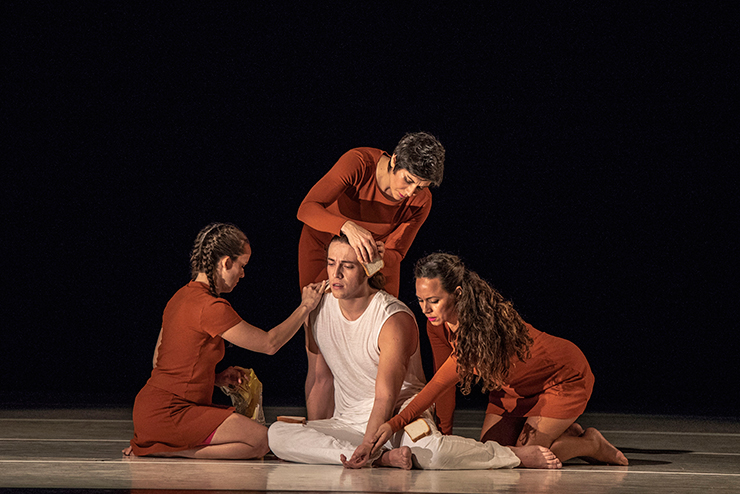
Rosie Herrera has been traveling the states with her company, Rosie Herrera Dance Theater, offering performances, lecture demonstrations, and having explicit conversations that ignite and influence the works that she creates and the emotions that she provokes. After a four year hiatus, audiences will have the opportunity to see Herrera’s company in her hometown of Miami as Miami Light Project presents “Carne Viva” or "open wound" in Wynwood beginning Thursday, April 11 through Saturday, April 13. “Carne Viva” is the first part of a trilogy that is a realistic and, oftentimes, raw perspective on transcendence, romance and religion.
When opportunity knocks, one must respond. I was working in Eugene, Oregon, with the Eugene Ballet. At the same time, Herrera and four of her dancers were in the midst of a residency at Reed College in Portland. They were presenting a lecture demonstration that was an opportunity for me to, not only see Herrera’s creative process, but to hear her speak about how and why she does what she does. It was an eye-opening experience and revealed much about the foundational impetus behind her creations.
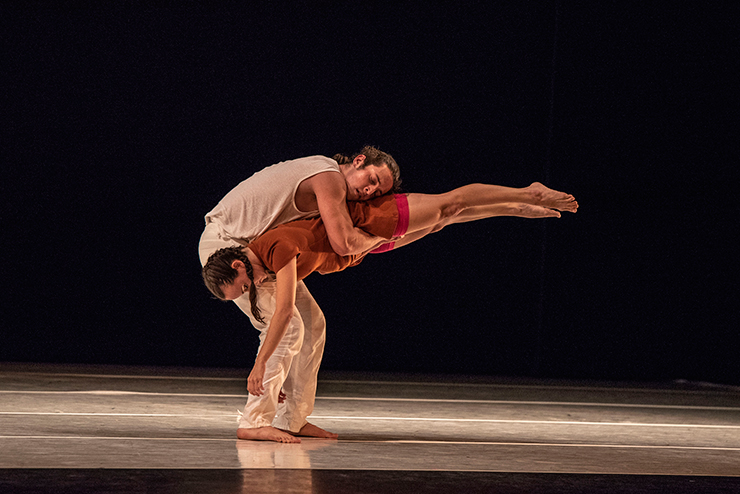
Herrera works on an idea for a long time, even after she has done her research and has fairly strong thoughts about where she wants to go. She derives input from her dancers and allows the process to evolve under her guidance and with her thought process, even when it evolves to a completely different result. Her work is not based in “dance technique” per se, but is grounded in human emotion, very raw human emotion, that must be real. Each showing is an exhausting journey for the performers as she pushes them to reach into their emotional and experiential depths to expose their innermost selves to the audience.
The trilogy is comprised of three pieces, “Carne Viva,” that will be shown in Miami, “Make Believe,” and another, as yet, to be named piece.
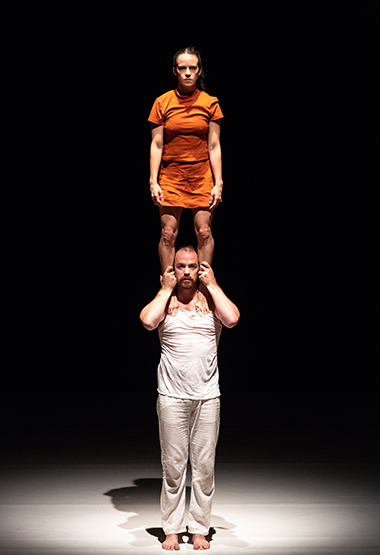
Herrera says, “With support from the National Dance Project, we have been touring mostly the South with our show, 'Make Believe.' It wasn’t specifically meant for the South, but that’s what ended up happening. I think there is a very personal connection to the subject matter that’s very thick in the South. There was a strong combination of similarities between the work and the places we were touring.”
“I felt there were a lot of entry points for people,” she continued. “This tour, interestingly enough, has given some of the most incredible feedback and conversations and relationships that I’ve ever had with audiences.”
During the tour, each conversation with educational academics, religious academics, scholars or historians became a big part of creating and influencing her work, a conversation that she wants to continue.
The subject of religious overtones plays a large role in these particular pieces of the trilogy. Herrera explained how the trilogy evolved and why religious themes prevail.
“I asked myself this question, ‘How would or how does introduction of faith predispose you to the unique experience of romantic love.?' That question turned into three different works. It’s my first time making a trilogy, I don’t know what that means,” she laughed.
“With this question in mind, 'Carne Viva' was the first work I created. What I was really interested in was the nature of transcendence. There’s this notion that transcendence in general is like 'Ahhh' (she sings). However, it’s often really ugly. I think that’s true for personal relationships and spiritual experience.”
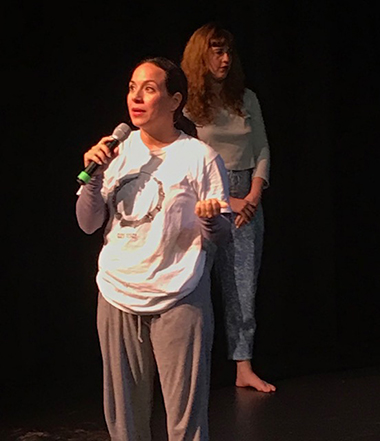
Rosie Hererra speaking in Portland.
“Also, as a choreographer, I wanted to give myself the challenge of working rather minimalistically. Working with a small cast, no props, no costumes. There is a rawness that I was interested in.”
Herrera’s work seems to touch everyone in unique ways and oftentimes, reaches very sensitive personal emotions. Audiences respond very radically to the visceral emotions.
“I think the deeper you dig, the more universal your message becomes. I hope that we’re expressing together, the deepest parts of who we are. I think the audience can sense that.”
“But truly,” she says, “ I think it’s a testament to the dancers’ ability to be vulnerable. I think that’s the beauty of intimacy, the shared vulnerability.”
An advocate for dance, Herrera uses movement as the vehicle to portray the emotions that she is conveying.
“A movement can feel in control and out of control at the same time. Our emotional life, our spiritual life is not this linear, clear narrative. It’s an abstract and complicated experience filled with dichotomies and that’s the truth of dance. It speaks an emotional honesty. That’s why I love dance.”
As happens often in choreography, life experience and life crisis often influence the work that is being manifested. For “Carne Viva,” Herrera was exploring deconstruction of gender roles and realized in the process how much her upbringing in the Catholic faith was influencing her thoughts; God the father, she recalls, an all powerful male figure in her life and how she understood herself as a woman in the world.
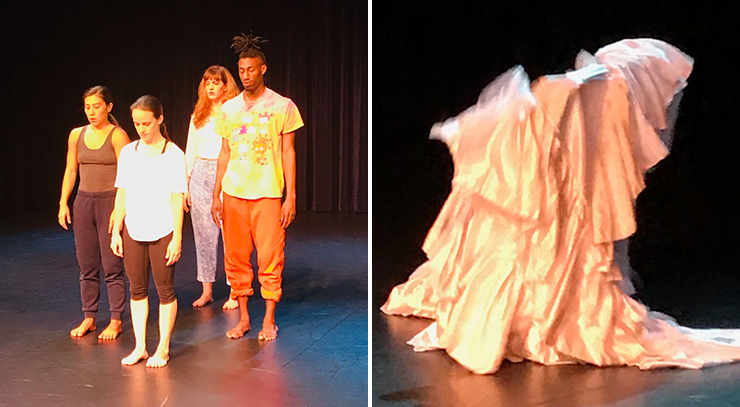
LEFT: The four dancers are: Ivonne Batanero, Rayne Raney, Britney Tokumoto and Katie Stirman. RIGHT: From her newest work in progress.
A particular gesture that she didn’t even realize she was repeating over and over in conversation with her dancers became the opening move for the piece.
“I sound like such a hippie,” she says, “but I try to really build my listening skills so I can let the piece reveal itself to me. I tend to think and feel in images and sometimes I get a really strong image in my head, and I’m not sure what that means, but I know what it feels like. So polishing that sense is very important in terms of understanding what the work should be. So, in the studio, I can move from that place of clarity and that sensation. Sometimes I have a very clear sense of physicality, which I did for this specific work.”
Having a background in hip hop, theater, and cabaret solidified the importance of having an individuality, style and personality in her work. To that end, Herrera is not afraid to move outside the box in her performances to delve into deep and sometimes hidden emotions in whatever means she deems necessary.
On the other extreme, while she doesn’t set out to be funny, humor is often used as a powerful tool.
“I like things that make me laugh. I have a lot of very funny people in the room. If we foster a sense of play and curiosity in the rehearsal room, then that translates into the work and people want to be around that. You want to go to a show where you think the people on stage actually like each other.”
“This is a big homecoming for us to do this show in Miami. We’ve been touring this piece for three years and it feels like its come full circle to come back and do it at Miami Light Project. It’s incredibly different from anything I’ve shown in Miami before and I’m excited for audiences to see this different part of our company.”
Performances are 8 p.m. Thursday, Friday and Saturday, April 11, 12, and 13 at The Light Box at Goldman Warehouse, 404 NW 26 Street, Miami, FL 33127. For tickets, miamilightproject.com. Call 305-576-4350 for information.
Each performance will be followed by an interactive discussion/conversation hosted by scholars from the Miami community.
- Thursday: Barry University dance scholar and critic, Celeste Landeros will join Herrera and collaborators in a conversation that takes “Carne Viva” as a point of departure for a conversation on love, transcendence, and Catholic mysticism.
- Friday: Join Rosie Herrera Dance Theatre in conversation with director and dramaturg Michael Yawney regarding the interplay between religion, ritual and sexuality.
- Saturday: Join Rosie Herrera in conversation with Jenni Person (in Studio B) as we discuss the unique history and significance of the Quartet for the End of Time, an iconic piece of chamber music by the French composer Olivier Messiaen who wrote the piece while a prisoner of war in German captivity.




